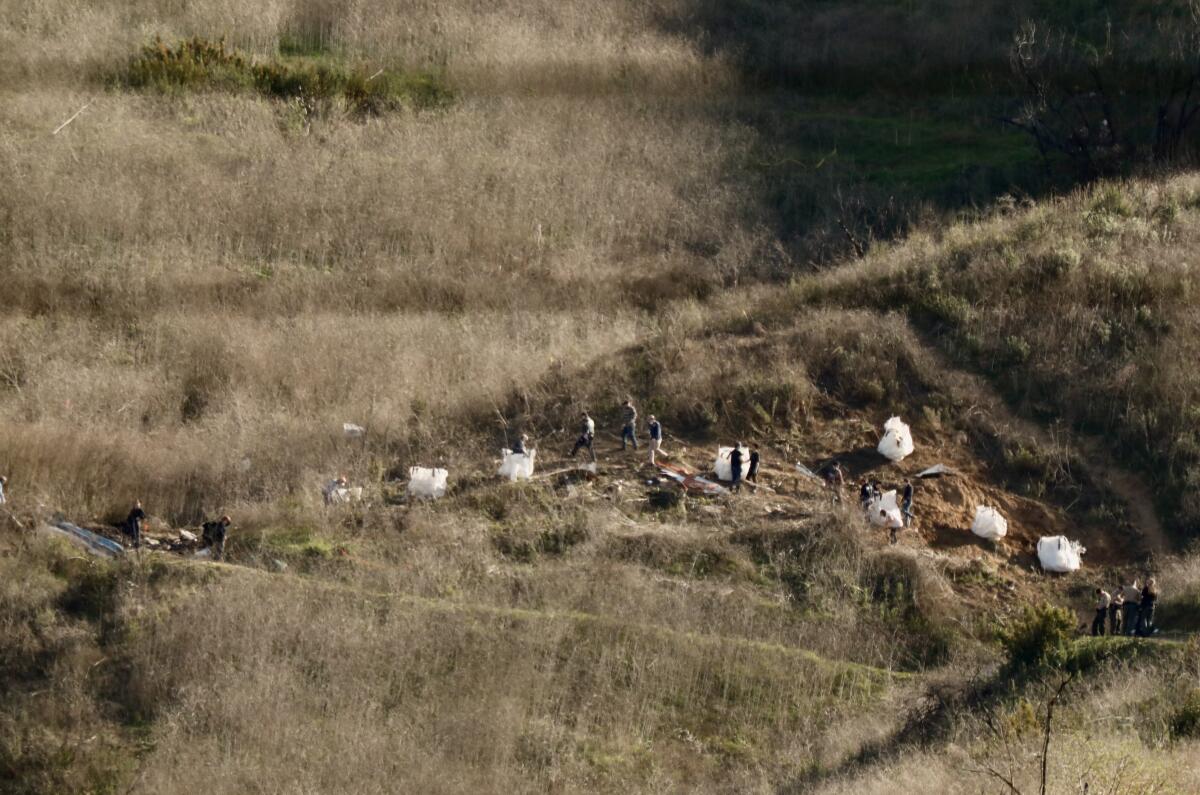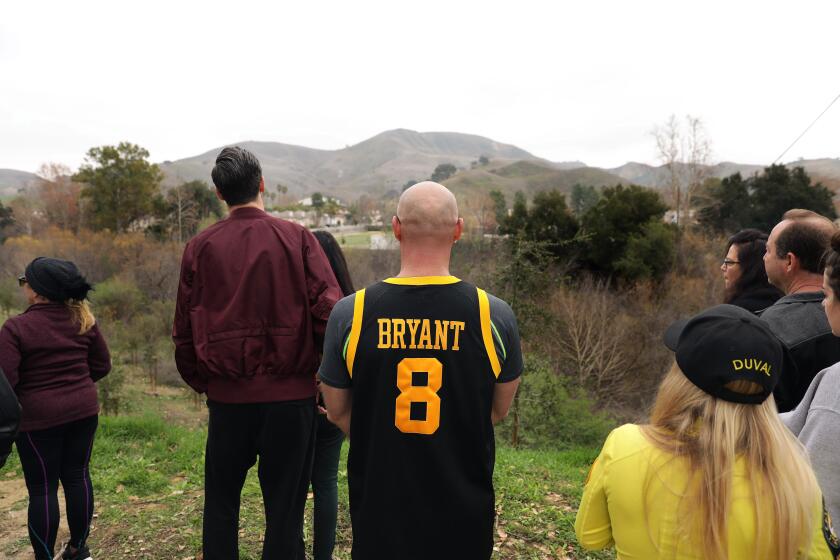Experts cite weather, the ‘largest killer in aviation,’ as likely key factor in Kobe Bryant helicopter crash

- Share via
The light haze that had settled on the runway of John Wayne Airport when Kobe Bryant, his 13-year-old daughter, Gianna, and six other passengers boarded a helicopter Sunday morning likely would not have posed much of a concern to a helicopter pilot with nearly 20 years of flying experience.
But conditions changed about a half-hour later, when the aircraft was flying over thickening clouds in the San Fernando Valley that reduced visibility predicted earlier in the day. Visibility had diminished so much that the Los Angeles Police Department had grounded its own fleet of helicopters that morning.
The helicopter ferrying Kobe and his guests — a Sikorsky S-76 chopper built in 1991 — circled for roughly 13 minutes over Glendale awaiting clearance from air traffic controllers to continue its trip under special visual flight rules that would grant clearance to fly in weather conditions with less than the minimum visibility for regular visual flying.
Tracing Kobe Bryant’s fateful last flight Sunday morning that ended with a horrific crash.
Experts say that at that point, the pilot had a decision to make. He could turn back, begin flying using the helicopter’s instruments and find a nearby airport to safely land, or press on. The pilot, identified by colleagues as Ara Zobayan, continued the flight toward Camarillo Airport. Minutes later, the helicopter crashed into a hillside in Calabasas, killing all nine people on board.
While less-than-ideal weather is not uncommon for experienced pilots, flying when visibility is decreasing poses an extreme danger, experts say.
“The largest killer in aviation, bar none, is weather,” said Michael Lenz, a retired safety program analyst with the Federal Aviation Administration. “The types of weather where this occurs aren’t usually severe like thunderstorms, but simply restrictions to visibility.”
Investigators combing the crash site this week are focusing on weather as one of the factors that may have contributed to the crash. National Transportation Safety Board investigator Jennifer Homendy has asked the public to send in any photos that showed weather conditions near the crash site Sunday. Investigators also are probing other aspects of the flight, including the pilot’s background, the airworthiness of the helicopter and whether a mechanical failure played a role in the crash.
“Our mission is not to just determine what happened, but why it happened and how it happened to prevent … a similar accident from ever happening again,” Homendy said.
On Tuesday, the NTSB announced that the helicopter was not equipped with a terrain alarm system that could have warned the pilot he was approaching a hillside. Homendy said her agency had recommended 16 years ago that the FAA require all choppers carrying six or more passengers be equipped with a terrain-awareness and warning system. Homendy said the FAA “failed to act” on the proposal.
While experts have not ruled out any factors that may have contributed to the crash, those who are familiar with the aircraft and the conditions the pilot was flying in say mechanical issues are an unlikely cause.
A flight under visual flight rules, which the pilot was on, is based on the principle of see and avoid. When operation of an aircraft under VFR isn’t safe, often because of inclement weather, FAA rules allow a pilot to fly under instrument rules, meaning the pilot navigates only by instruments in the cockpit.
As Zobayan approached the hills of Calabasas at 150 mph, air traffic control radioed him, telling him he was too low to be seen on radar. Four minutes later, the pilot advised he was climbing to avoid a cloud layer. He rose roughly 875 feet in less than a minute and then began a descending turn before slamming into the hillside, according to a Times analysis of flight data.
Randy Waldman, a helicopter flight instructor in Los Angeles, said based on the information provided by authorities, and the pilot’s rapid incline and descent, the pilot could have become disoriented in the dense, patchy fog that had obscured some of the area and went into a fatal dive.
“It’s very possible that it went from bad visibility to no visibility in a second,” he said. “The top of the hillside that morning was completely obscured.”
When a pilot is flying using only sight, he or she uses the horizon to keep the aircraft level. When Zobayan began making a left turn over the hills in Calabasas, Waldman suspects that’s “where he lost sight of the horizon and got disoriented.”
“At that point it was too late to do anything,” Waldman said.
The FAA’s helicopter flying handbook states that losing all visual references during a flight “can cause sensory overload” for a pilot, who can then lose the ability to think rationally. In some instances, instead of slowing the helicopter, a pilot will increase airspeed.
“This can be caused by an oculogravic illusion. This type of illusion occurs when an aircraft accelerates and decelerates. Inertia from linear accelerations and decelerations cause the otolith organ to sense a nose-high or nose-low attitude,” the handbook states. “Pilots falsely perceive that the aircraft is in a nose-high attitude. Therefore, pilots increase airspeed.”
Steve Sparks, a former aviation safety inspector with the FAA, wrote in a February 2016 article for Heliweb Magazine that more than two-thirds of all weather-related helicopter accidents result in at least one fatality — a rate three times higher than other general aviation accidents. Sparks wrote that a common factor in many such crashes was the pilot’s decision to keep flying.
Lenz noted that the pilot could have switched to an instrument approach, which would have required him to take a path set by air traffic control, extending flying time. He said pilots are “result- and mission-oriented” and can feel a certain pressure to complete a flight to the satisfaction of a client. That factor may have been at play on Sunday, he said.
“Of course, hindsight is always perfect,” he said. “We can say maybe if they had turned around, they would be alive today, but we don’t know.”
More to Read
Sign up for Essential California
The most important California stories and recommendations in your inbox every morning.
You may occasionally receive promotional content from the Los Angeles Times.













